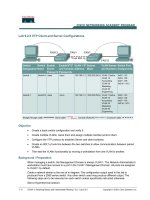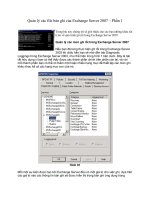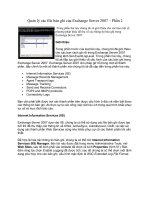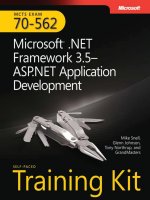java ee 5 with glassfish application server, 2007
Bạn đang xem bản rút gọn của tài liệu. Xem và tải ngay bản đầy đủ của tài liệu tại đây (12.51 MB, 421 trang )
Java EE 5 Development using
GlassFish Application Server
The complete guide to installing and configuring the
GlassFish Application Server and developing Java EE 5
applications to be deployed to this server
David R. Heffelfinger
BIRMINGHAM - MUMBAI
Java EE 5 Development using GlassFish
Application Server
The complete guide to installing and configuring the GlassFish
Application Server and developing Java EE 5 applications to be
deployed to this server
Copyright © 2007 Packt Publishing
All rights reserved. No part of this book may be reproduced, stored in a retrieval
system, or transmitted in any form or by any means, without the prior written
permission of the publisher, except in the case of brief quotations embedded in
critical articles or reviews.
Every effort has been made in the preparation of this book to ensure the accuracy of
the information presented. However, the information contained in this book is sold
without warranty, either express or implied. Neither the author, Packt Publishing,
nor its dealers or distributors will be held liable for any damages caused or alleged to
be caused directly or indirectly by this book.
Packt Publishing has endeavored to provide trademark information about all the
companies and products mentioned in this book by the appropriate use of capitals.
However, Packt Publishing cannot guarantee the accuracy of this information.
First published: October 2007
Production Reference: 1031007
Published by Packt Publishing Ltd.
32 Lincoln Road
Olton
Birmingham, B27 6PA, UK.
ISBN 978-1-847192-60-8
www.packtpub.com
Cover Image by Vinayak Chittar ()
Credits
Author
David R. Heffelfinger
Reviewers
Meenakshi Verma
Kim Mark Lewis
Acquisition Editor
Priyanka Baruah
Technical Editor
Ajay.S
Editorial Manager
Dipali Chittar
Project Manager
Patricia Weir
Project Coordinator
Sagara Naik
Indexer
Monica Ajmera
Proofreader
Chris Smith
Production Coordinator
Shantanu Zagade
Cover Designer
Shantanu Zagade
About the Author
David Heffelnger has been developing software professionally since 1995;
he has been using Java as his primary programming language since 1996. He has
worked on many large-scale projects for several clients including Freddie Mac,
Fannie Mae, and the US Department of Defense. He has a Masters degree in Software
Engineering from Southern Methodist University. David is editor in chief of
Ensode.net (), a website about Java, Linux, and other
technology topics.
First and foremost, I would like to thank my family for putting up
with me spending several hours a day working on this book; without
your support, I wouldn't have been able to accomplish this.
I would also like to thank the Packt Publishing staff for their help
and support in getting this book published. I am especially grateful
to Priyanka Baruah, who rst contacted me regarding this book,
Patricia Weir for her patience regarding the several changes to the
book's outline, Sagara Naik for keeping track of the schedule. I
would also like to thank the technical reviewers, Kim Lewis and
Meenakshi Verma for providing excellent suggestions. Last but not
least, I would also like to thank Douglas Paterson, who gave me the
opportunity to get my rst book published (and who wished to
work on a second book with me) for supporting my decision to work
on this book.
About the Reviewers
Meenakshi Verma has more than nine years of experience in Analysis, Design,
Development, and Implementation of stand-alone and web-based applications using
various languages like Java-based technologies, C, and BBx. She is procient in
developing applications using J2EE technologies.
Meenakshi has also done the technical review of the Packt book titled Jasper Reports
for Java Developers by David Heffelnger.
She is currently working at Sapient's Toronto Ofce.
Kim Mark Lewis has been a consultant since 1991 to the US Federal Government,
working on nancial and human resource systems for a variety of agencies such
as NASA, the Federal Communications Commission, the Federal Reserve Board,
the Department of the Army, and the Department of the Navy. Kim divides his
professional programming life between Java and .NET. He is married and has one
daughter and is currently living in the Washington D.C. area.
Table of Contents
Preface 1
Chapter 1: Getting Started with GlassFish 5
Overview of Java EE and GlassFish 5
GlassFish Advantages 6
Obtaining GlassFish 7
Installing GlassFish 8
GlassFish Dependencies 8
Performing the Installation 8
Verifying the Installation 10
Deploying Our First Java EE Application 12
Deploying an Application through the Web Console 12
Undeploying an Application through the Web Console 17
Deploying an Application through the Command Line 19
Undeploying an Application through the Command Line 20
GlassFish Domains Explained 21
Creating Domains 21
Deleting Domains 23
Stopping a Domain 23
Setting Up Database Connectivity 24
Setting Up Connection Pools 24
Summary 31
Chapter 2: Servlet Development and Deployment 33
Writing Our First Servlet 34
Compiling the Servlet 36
Configuring the Servlet 37
Packaging the Web Application 38
Deploying the Web Application 40
Testing the Web Application 40
Processing HTML Forms 42
Table of Contents
[ ii ]
Request Forwarding and Response Redirection 49
Request Forwarding 49
Response Redirection 53
Persisting Application Data across Requests 56
Summary 59
Chapter 3: JavaServer Pages 61
Introduction to JavaServer Pages 61
Developing Our First JSP 62
JSP Implicit Objects 65
JSPs and JavaBeans 73
Reusing JSP Content 78
JSP Custom Tags 81
Extending SimpleTagSupport 81
Using Tag Files to Create Custom JSP Tags 87
Unified Expression Language 91
Summary 95
Chapter 4: Database Connectivity 97
The CustomerDB Database 97
JDBC 99
Retrieving Data from a Database 99
Modifying Database Data 107
The Java Persistence API 109
Entity Relationships 115
One-to-One Relationships 116
One-to-Many Relationships 122
Many-to-Many Relationships 128
Composite Primary Keys 134
Java Persistence Query Language 139
Final Notes 142
Summary 143
Chapter 5: JSP Standard Tag Library 145
Core JSTL Tag Library 145
Formatting JSTL Tag Library 154
SQL JSTL Tag Library 158
XML JSTL Tag Library 163
JSTL Functions 167
Summary 171
Chapter 6: JavaServer Faces 173
Developing Our First JSF Application 172
Custom Data Validation 184
Table of Contents
[ iii ]
Creating Custom Validators 184
Validator Methods 187
Customizing JSF's Default Messages 191
Integrating JSF and JPA 196
JSF Core Components 203
<f:actionListener> 203
<f:attribute> 203
<f:convertDateTime> 204
<f:convertNumber> 204
<f:converter> 204
<f:facet> 205
<f:loadBundle> 206
<f:param> 206
<f:phaseListener> 206
<f:selectItem> 206
<f:selectItems> 207
<f:setPropertyActionListener> 207
<f:subview> 207
<f:validateDoubleRange> 208
<f:validateLength> 208
<f:validateLongRange> 208
<f:validator> 209
<f:valueChangeListener> 209
<f:verbatim> 209
<f:view> 209
JSF HTML Components 210
<h:column> 210
<h:commandButton> 210
<h:commandLink> 211
<h:dataTable> 211
<h:form> 211
<h:graphicImage> 212
<h:inputHidden> 212
<h:inputSecret> 212
<h:inputText> 212
<h:inputTextarea> 212
<h:message> 213
<h:messages> 213
<h:outputFormat> 213
<h:outputLabel> 214
<h:outputLink> 214
<h:outputText> 214
<h:panelGrid> 215
<h:panelGroup> 215
<h:selectBooleanCheckbox> 216
<h:selectManyCheckbox> 217
<h:selectManyListbox> 217
<h:selectManyMenu> 217
<h:selectOneListbox> 217
Table of Contents
[ iv ]
<h:selectOneMenu> 218
<h:selectOneRadio> 218
Additional JSF Tag Libraries 218
Summary 219
Chapter 7: Java Messaging Service 221
Setting Up GlassFish for JMS 221
Setting Up a JMS Connection Factory 221
Setting Up a JMS Message Queue 226
Setting Up a JMS Message Topic 227
Message Queues 228
Sending Messages to a Message Queue 228
Retrieving Messages from a Message Queue 232
Asynchronously Receiving Messages from a Message Queue 234
Browsing Message Queues 237
Message Topics 239
Sending Messages to a Message Topic 239
Receiving Messages from a Message Topic 241
Creating Durable Subscribers 243
Summary 246
Chapter 8: Security 247
Security Realms 247
Predefined Security Realms 248
admin-realm 249
The file Realm 251
The certificate Realm 265
Defining Additional Realms 273
Defining Additional File Realms 273
Defining Additional Certificate Realms 274
Defining an LDAP Realm 275
Defining a Solaris Realm 276
Defining a JDBC Realm 277
Defining Custom Realms 283
Summary 289
Chapter 9: Enterprise JavaBeans 291
Session Beans 292
Simple Session Bean 292
A More Realistic Example 295
Invoking Session Beans from Web Applications 298
Message-Driven Beans 301
Transactions in Enterprise Java Beans 302
Container-Managed Transactions 302
Bean-Managed Transactions 306
Table of Contents
[ v ]
Enterprise JavaBean Life Cycles 308
Stateful Session Bean Life Cycle 308
Stateless Session Bean Life Cycle 312
Message-Driven Bean Life Cycle 313
EJB Timer Service 313
EJB Security 316
Client Authentication 320
Summary 322
Chapter 10: Web Services 323
Developing Web Services with JAX-WS 323
Developing a Web Service Client 330
Sending Attachments to Web Services 336
Exposing EJBs as Web Services 339
EJB Web Service Clients 340
Securing Web Services 341
Securing EJB Web Services 343
Summary 345
Chapter 11: Beyond Java EE 347
Facelets 347
Downloading Facelets 348
Configuring Our Facelets Application 349
Writing a Facelets Application 351
Facelets Templating 359
Ajax4jsf 364
Downloading Ajax4jsf 364
Configuring Our JSF Application for Ajax4jsf 365
Writing an AJAX-Enabled Application with Ajax4jsf 366
Seam 373
Downloading Seam 374
Configuring a Seam Application 375
Developing a Seam Application 379
Summary 385
Appendix A: Sending Email from Java EE Applications 387
GlassFish Configuration 387
Implementing Email Delivery Functionality 391
Appendix B: IDE Integration 395
NetBeans 395
Eclipse 397
Index 403
Preface
Project GlassFish was formally announced at the 2005 JavaOne conference. Version
one of the GlassFish application server was released to the public approximately
a year later, at the 2006 JavaOne conference. GlassFish version one became the
reference implementation for the Java EE 5 specication, and as such, was the rst
available application server compliant with this specication.
While releasing the rst available Java EE 5 application server was a tremendous
accomplishment, the rst version of GlassFish lacked some enterprise features such
as clustering and High Availability. GlassFish version 2, released in September 2007,
added these and other enterprise features, in addition to other features such as an
enhanced web based administration console.
This book will guide you through the development and deployment of Java
EE 5-compliant application on GlassFish version 2. It also covers application
development using frameworks that build on top of the Java EE 5 specication,
including Facelets, Ajax4jsf, and Seam.
What This Book Covers
Chapter 1 provides an overview of Glasssh, including how to install it, congure it,
and verify the installation.
Chapter 2 covers how to develop server-side web applications using the Servlet API.
Chapter 3 explains how to develop web applications using JavaServer Pages (JSPs),
including how to develop and use JSP custom tags.
Chapter 4 discusses how to develop Java EE applications that interact with a
relational database system through the Java Persistence API (JPA) and through the
Java Database Connectivity API (JDBC).
Preface
[ 2 ]
Chapter 5 explains how to use the JSP Standard Tag Library (JSTL) when developing
JavaServer Pages.
Chapter 6 covers how to develop applications using the JavaServer Faces (JSF)
component framework to build web applications.
Chapter 7 explains how to develop messaging applications though the Java
Messaging Service (JMS) API.
Chapter 8 covers securing J2EE applications through the Java Authentication and
Authorization Service (JAAS).
Chapter 9 discusses how to develop Enterprise Java Beans that adhere to the
EJB 3 specication.
Chapter 10 explains how to develop and deploy web services that conform to the
JAX-WS 2.1 specication.
Chapter 11 covers frameworks that build on top of the Java EE 5 specication,
including Seam, Facelets, and Ajax4Jsf.
Appendix A covers sending email from Java EE Applications.
Appendix B covers IDE integration.
Who is This Book for
This book is aimed at Java developers wishing to become procient with Java EE 5,
who are expected to have some experience with Java and to have developed and
deployed applications in the past, but need no previous knowledge of Java EE or
J2EE. It teaches the reader how to use GlassFish to develop and deploy applications.
Conventions
In this book, you will nd a number of styles of text that distinguish between
different kinds of information. Here are some examples of these styles, and an
explanation of their meaning.
There are three styles for code. Code words in text are shown as follows: "We can
include other contexts through the use of the include directive."
Preface
[ 3 ]
A block of code will be set as follows:
<head>
<meta http-equiv="Content-Type" content="text/html; charset=UTF-8">
<title>Server Date And Time</title>
</head>
When we wish to draw your attention to a particular part of a code block, the
relevant lines or items will be made bold:
</head>
<body>
<p>Server date and time: <% out.print(new Date()); %>
</p>
</body>
New terms and important words are introduced in a bold-type font. Words that you
see on the screen, in menus or dialog boxes for example, appear in our text like this:
"clicking the Next button moves you to the next screen".
Important notes appear in a box like this.
Tips and tricks appear like this.
Reader Feedback
Feedback from our readers is always welcome. Let us know what you think about
this book, what you liked or may have disliked. Reader feedback is important for us
to develop titles that you really get the most out of.
To send us general feedback, simply drop an email to ,
making sure to mention the book title in the subject of your message.
If there is a book that you need and would like to see us publish, please send
us a note in the SUGGEST A TITLE form on www.packtpub.com or email
If there is a topic that you have expertise in and you are interested in either writing
or contributing to a book, see our author guide on www.packtpub.com/authors.
Preface
[ 4 ]
Customer Support
Now that you are the proud owner of a Packt book, we have a number of things to
help you to get the most from your purchase.
Downloading the Example Code for the Book
Visit and select this book from the list of titles
to download any example code or extra resources for this book. The les available
for download will then be displayed.
The downloadable les contain instructions on how to use them.
Errata
Although we have taken every care to ensure the accuracy of our contents, mistakes
do happen. If you nd a mistake in one of our books—maybe a mistake in text or
code—we would be grateful if you would report this to us. By doing this you can
save other readers from frustration, and help to improve subsequent versions of
this book. If you nd any errata, report them by visiting ktpub.
com/support, selecting your book, clicking on the Submit Errata link, and entering
the details of your errata. Once your errata are veried, your submission will be
accepted and the errata added to the list of existing errata. The existing errata can be
viewed by selecting your title from />Questions
You can contact us at if you are having a problem with
some aspect of the book, and we will do our best to address it.
Getting Started with
GlassFish
In this chapter, we will discuss how to get started with GlassFish. Some of the topics
discussed in this chapter are:
An overview of Java EE and GlassFish
Obtaining GlassFish
Installing GlassFish
Verifying the GlassFish Installation
Deploying Java EE Applications
Setting Up Database Connectivity
Overview of Java EE and GlassFish
Java EE (formerly called J2EE) is a standard set of technologies for server-side
Java development. Java EE technologies include Servlets, JavaServer Pages (JSPs),
JavaServer Faces (JSF), Enterprise JavaBeans (EJBs), and the Java Messaging
Service (JMS).
Several commercial and open-source application Java EE servers exist. Java EE
application servers, such as GlassFish, allow application developers to develop
and deploy Java EE-compliant applications. Other open-source Java EE application
servers include Red Hat's JBoss, the Apache Software Foundation's Geronimo, and
ObjectWeb's JOnAS.
Commercial application servers include BEA's Weblogic, IBM's Websphere, and the
Oracle Application Server.
•
•
•
•
•
•
Getting Started with GlassFish
[ 6 ]
GlassFish is an open-source, freely available, Java EE application server. GlassFish
is dual licensed under the Common Development and Distribution License (CDDL)
and the GNU Public License (GPL) version 2.
To nd out more about GlassFish's license, see
/>Like all Java EE-compliant application servers, GlassFish provides the necessary
libraries to allow us to develop and deploy Java applications compliant with
Java EE specications.
GlassFish Advantages
With so many options in Java EE application servers, why choose GlassFish? Besides
the obvious advantage of GlassFish being available free of charge, it offers the
following benets:
It is made by Sun Microsystems
Sun Microsystems is the steward of Java language, and the
Java EE specication.
Commercial support is available
Sun Microsystems sells a re-packaged version of GlassFish
called the Sun Java System Application Server. Commercial
support is available (at a cost) from Sun Microsystems for this
re-packaged GlassFish version. Many software development
shops will not use any software for which commercial
support is not available; therefore commercial support
availability allows GlassFish to be used in environments
where it otherwise wouldn't be.
It is the Java EE reference Implementation
GlassFish is the Java EE Reference implementation. What this
means is that other application servers may use GlassFish
to make sure their product complies with the specication.
GlassFish could theoretically be used to debug other
application servers. If an application deployed under another
application server is not behaving properly, but it does
behave properly when deployed under GlassFish, then it is
more than likely that the improper behavior is due to a bug in
the other application server.
•
°
•
°
•
°
Chapter 1
[ 7 ]
It supports the latest versions of the Java EE specication
GlassFish is the reference Java EE specication, so it tends
to implement the latest specications before any other
application server in the market.
Obtaining GlassFish
GlassFish can be downloaded from by clicking
an image that looks like this:
The image should be near the top right window of the page.
After clicking on the image, and scrolling down to a section titled Binary builds
around the middle of the resulting page, you should see links to download GlassFish
for several different architectures. Currently Solaris Sparc, Solaris x86, Windows,
Linux, and MacOS are supported.
•
°
Getting Started with GlassFish
[ 8 ]
To download GlassFish, simply click on the link for your platform; the le should
start downloading immediately. After the le nishes downloading, you should
have a le called something like glassfish-installer-v2-b58g.jar; the exact le
name will depend on the exact GlassFish version and platform.
Installing GlassFish
Installing GlassFish is an easy process; however, GlassFish assumes that some
dependencies are present in your system.
GlassFish Dependencies
Before GlassFish can be installed, a recent version of the Java Development Kit must
be present in your system and (optionally) the Apache ANT tool.
Java Development Kit
In order to install GlassFish, a recent version of the
Java Development Kit (JDK) must be installed on your
workstation (JDK 1.5 or newer required), and the java
executable must be in your system PATH. The latest JDK can
be downloaded from Please refer to
the JDK installation instructions for your particular platform
at />index.html.
ANT (Optional)
Ant is a very popular build tool; it can be downloaded from
. A version of ANT is included
with GlassFish, therefore this step is optional. If you already
have ANT installed on your system you can use it to install
GlassFish. Just make sure that the ant script is executable and
in your system's PATH. Please note that GlassFish requires
ANT 1.6.5 or later.
Performing the Installation
Once the dependencies have been installed, copy the le downloaded in the previous
section to an appropriate installation location and run the following command from
a terminal window:
java -Xmx256m -jar glassfish-installer-v2-b58g.jar
•
°
•
°
Chapter 1
[ 9 ]
The actual le name at the end of the command will depend on the
version of GlassFish downloaded.
After running this command, a window prompting you to accept the license terms
will show up.
Scroll all the way down and click on the button labeled Accept.
You should see a lot of text scrolling on your terminal window, after the text stops
scrolling, you should see the following text at the bottom of your terminal window:
installation complete.
The installer creates a directory called glassfish at the location where we ran the
above command from.
Although we saw the above message when we completed the step required in
the previous paragraph, we are not quite done installing GlassFish. Inside the
glassfish directory, there is an ANT build script that must be executed to complete
the installation. The le name for this build script is setup.xml. This script can be
executed from the command line by changing to the GlassFish installation directory
and typing the following command:
ant -f setup.xml
Getting Started with GlassFish
[ 10 ]
After executing this command you should see the following message at the bottom
of the terminal the time taken may vary:
BUILD SUCCESSFUL
Total time: 43 seconds
The above command assumes that ANT 1.6.5 or newer is installed in the
system, and that the ant executable is in the system PATH. GlassFish
includes ANT; to access it from any directory add [glassfish
installation directory]/glassfish/lib/ant/bin to your
system PATH.
We have now successfully installed GlassFish and we are ready to start it for the
rst time.
Verifying the Installation
To start GlassFish, change directory to [glassfish installation directory]/
glassfish/bin, and execute the following command:
./asadmin start-domain domain1
The above command and most commands shown in this chapter assume
a Unix or Unix-like operating system. For Windows systems, the initial
"./" is not necessary.
After executing the above command you should see a message similar to the
following in the command line console:
Domain domain1 is ready to receive client requests. Additional services are being
started in background.
The above message will be followed by additional information indicating the ports
that GlassFish listens to and other information.
We can then open a browser window and type the following URL in the browser's
location text eld: http://localhost:8080.
Chapter 1
[ 11 ]
If everything went well you should see a page similar to the following:
Getting Help
If any of the above steps fail, a good place to ask for help is the
GlassFish forums at />jspa?forumID=56.
Getting Started with GlassFish
[ 12 ]
Deploying Our First Java EE Application
To further test that our GlassFish installation is running properly, we will deploy
a war (Web ARchive) le and make sure it deploys and executes properly. Before
moving on, please download the le simpleapp.war from this book's website.
Deploying an Application through the Web Console
To deploy simpleapp.war, open a browser and navigate to the following URL:
http://localhost:4848; you should be greeted with a login screen that looks like
the following:









